2010.5 Peugeot 508 Dag brake light
[x] Cancel search: brake lightPage 109 of 330
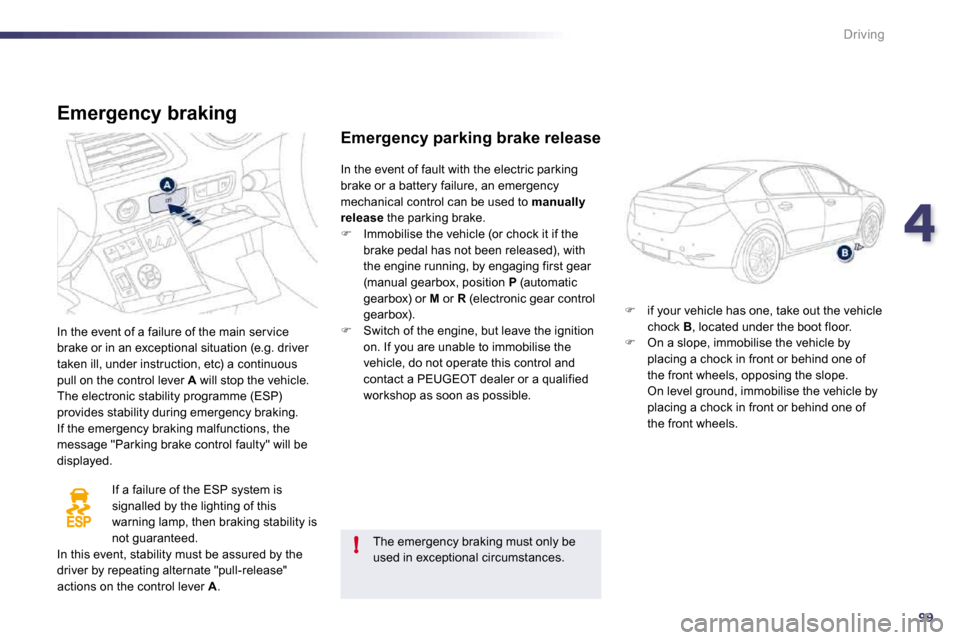
499
!
Driving
Emergency braking
In the event of a failure of the main ser vice brake or in an exceptional situation (e.g. driver taken ill, under instruction, etc) a continuous pull on the control lever A will stop the vehicle. The electronic stability programme (ESP) provides stability during emergency braking. If the emergency braking malfunctions, the message "Parking brake control faulty" will be displayed.
If a failure of the ESP system is signalled by the lighting of this warning lamp, then braking stability is
not guaranteed. In this event, stability must be assured by the driver by repeating alternate "pull-release" actions on the control lever A .
Emergency parking brake release
� if your vehicle has one, take out the vehicle chock B , located under the boot floor. � On a slope, immobilise the vehicle by placing a chock in front or behind one of the front wheels, opposing the slope. On level ground, immobilise the vehicle by placing a chock in front or behind one of the front wheels.
In the event of fault with the electric parking brake or a battery failure, an emergency mechanical control can be used to manually release the parking brake. � Immobilise the vehicle (or chock it if the brake pedal has not been released), with the engine running, by engaging first gear (manual gearbox, position P (automatic gearbox) or M or R (electronic gear control gearbox). � Switch of the engine, but leave the ignition on. If you are unable to immobilise the vehicle, do not operate this control and contact a PEUGEOT dealer or a qualified workshop as soon as possible.
The emergency braking must only be used in exceptional circumstances.
Page 113 of 330

499
!
Driving
Emergency braking
In the event of a failure of the main ser vice brake or in an exceptional situation (e.g. driver taken ill, under instruction, etc) a continuous pull on the control lever A will stop the vehicle. The electronic stability programme (ESP) provides stability during emergency braking. If the emergency braking malfunctions, the message "Parking brake control faulty" will be displayed.
If a failure of the ESP system is signalled by the lighting of this warning lamp, then braking stability is
not guaranteed. In this event, stability must be assured by the driver by repeating alternate "pull-release" actions on the control lever A .
Emergency parking brake release
� if your vehicle has one, take out the vehicle chock B , located under the boot floor. � On a slope, immobilise the vehicle by placing a chock in front or behind one of the front wheels, opposing the slope. On level ground, immobilise the vehicle by placing a chock in front or behind one of the front wheels.
In the event of fault with the electric parking brake or a battery failure, an emergency mechanical control can be used to manually release the parking brake. � Immobilise the vehicle (or chock it if the brake pedal has not been released), with the engine running, by engaging first gear (manual gearbox, position P (automatic gearbox) or M or R (electronic gear control gearbox). � Switch of the engine, but leave the ignition on. If you are unable to immobilise the vehicle, do not operate this control and contact a PEUGEOT dealer or a qualified workshop as soon as possible.
The emergency braking must only be used in exceptional circumstances.
Page 126 of 330

114
i
!
Driving
Stop & Start
The Stop & Star t system puts the engine temporarily into standby - STOP mode - during stops in the traffic (red lights, traffic jams, or other...). The engine restar ts automatically - START mode - as soon as y ou want to move off. The restar t takes place instantly, quickly and silently. Per fect for urban use, the Stop & Star t system reduce s fuel consumption and exhaust emissions as well as the noise level when stationary.
Operation
Going into engine STOP mode
The "ECO" warning lamp comes on in the instrument panel and the engine goes into standby:
- with the electronic gear control gearbox, at speeds below 4 mph (6 km/h), press the brake pedal or put the selector lever in position N .
If your vehicle is fitted with the system, a time counter calculates the sum of the periods in STOP mode during a journey. It rests itself to zero every time the ignition is switched on with the key.
Never refuel with the engine in STOP mode; you must switch off the ignition with the key.
For your comfor t, during parking maoeuvres, STOP mode is not available for a few seconds after coming out of reverse gear. STOP mode does not affect the functionality of the vehicle, such as for example, braking, power steering...
Special cases: STOP mode not available
STOP mode is not invoked when:
- the driver's door is open, - the driver's seat belt is not fastened, - the vehicle has not exceeded 6 mph (10 km/h) since the last engine star t using the key, - the electric parking brake is applied or being applied, - the engine is needed to maintain a comfor table temperature in the passenger compar tment, - demisting is active,
- some special conditions (battery charge, engine temperature, braking assistance, ambient temperature...) where the engine is needed to assure control of a system. In this case, the "ECO" warning lamp flashes for a few seconds then goes off. This operation is per fectly normal.
Page 174 of 330

7161
i
!
Safety
Snow driving assistance
(Intelligent Traction Control)
Your vehicle has a system to help driving on snow: Intelligent Traction Control . This automatic system continuously checks for situations of difficult sur face adhesion that could make it difficult to move off or make progress on deep fresh snow or compacted snow. In these situations, Intelligent Traction Control takes over from the ASR system, limiting the amount of wheel slip to provide the best traction and trajectory control, even without snow tyres and with or without chains. In extremely severe conditions (snow on top of ice, sand, deep mud…), it can be useful to deactivate the ESP/ASR systems to allow a degree of wheel spin and so recover grip.
Operation
Anti-lock braking system (ABS) and electronic brake force distribution (EBFD)
In emergency braking, press ver y firmly without releasing the pressure.
When changing wheels (tyres and rims), make sure that these are approved for your vehicle. Normal operation of the ABS may make itself felt by slight vibrations of the brake pedal.
When this warning lamp comes on, accompanied by an audible signal and a message, it indicates that there is a fault with the ABS, which could cause loss of control of the vehicle when braking.
When this warning lamp comes on, coupled with the STOP warning lamp, accompanied by an audible signal and a message, it indicates that there is a fault with the electronic brake force distribution (EBFD), which could cause loss of control of the vehicle when braking. You must stop as soon as it is safe to do so. In both cases, contact a PEUGEOT dealer or a
qualified workshop.
Page 203 of 330
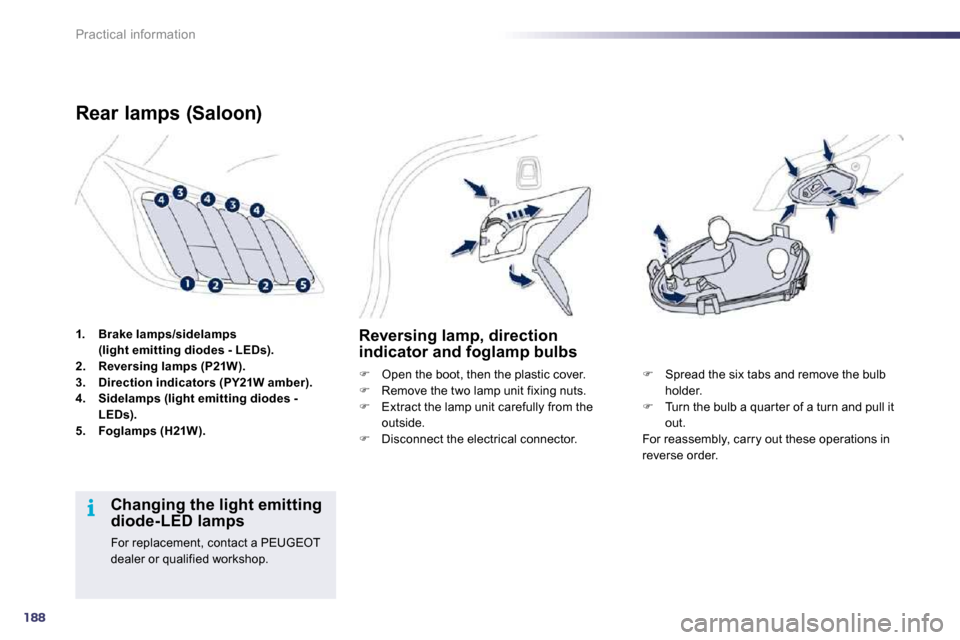
188
i
Practical information
1. Brake lamps/sidelamps (light emitting diodes - LEDs).2. Reversing lamps (P21W).3. Direction indicators (PY21W amber).4. Sidelamps (light emitting diodes - LEDs).5. Foglamps (H21W).
Rear lamps (Saloon)
Reversing lamp, direction indicator and foglamp bulbs
� Open the boot, then the plastic cover. � Remove the two lamp unit fixing nuts. � Extract the lamp unit carefully from the outside. � Disconnect the electrical connector.
� Spread the six tabs and remove the bulb holder. � Turn the bulb a quar ter of a turn and pull it out. For reassembly, carry out these operations in reverse order.
Changing the light emitting diode-LED lamps
For replacement, contact a PEUGEOT dealer or qualified workshop.
Page 204 of 330
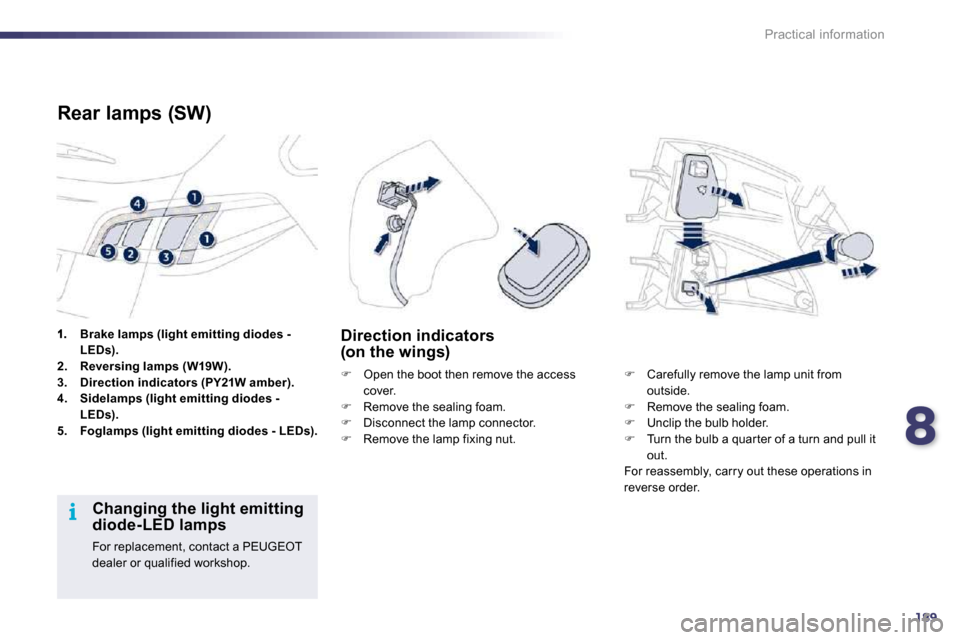
8189
i
Practical information
Brake lamps (light emitting diodes - LEDs).2. Reversing lamps (W19W).3. Direction indicators (PY21W amber).4. Sidelamps (light emitting diodes - LEDs).5. Foglamps (light emitting diodes - LEDs).
Rear lamps (SW)
� Open the boot then remove the access cover. � Remove the sealing foam. � Disconnect the lamp connector. � Remove the lamp fixing nut.
Direction indicators (on the wings)
� Carefully remove the lamp unit from outside. � Remove the sealing foam. � Unclip the bulb holder. � Turn the bulb a quar ter of a turn and pull it out. For reassembly, carry out these operations in reverse order.
Changing the light emitting diode-LED lamps
For replacement, contact a PEUGEOT dealer or qualified workshop.
Page 206 of 330
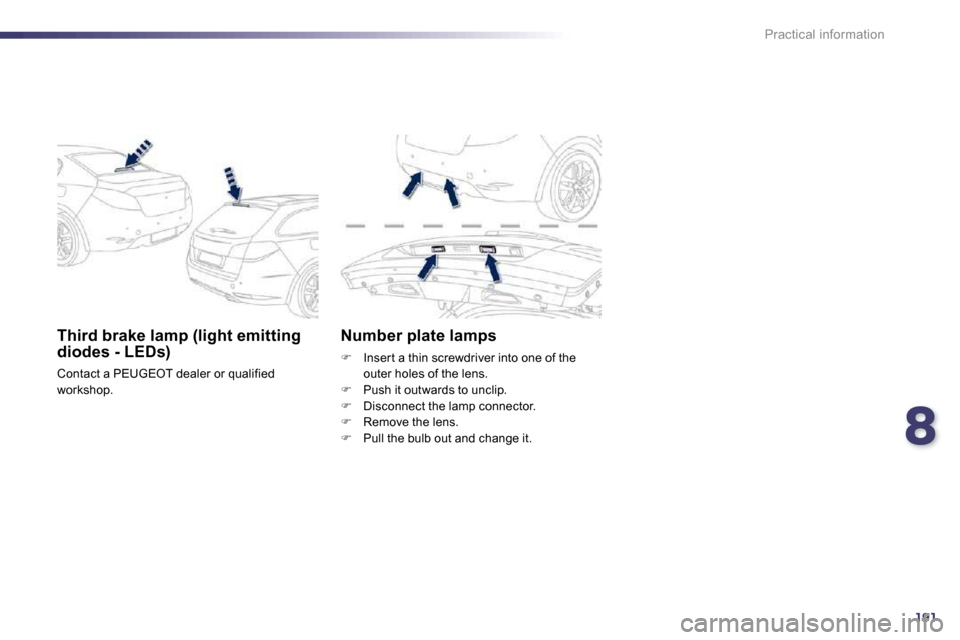
8191
Practical information
Third brake lamp (light emitting diodes - LEDs)
Contact a PEUGEOT dealer or qualified workshop.
Number plate lamps
� Inser t a thin screwdriver into one of the outer holes of the lens. � Push it outwards to unclip. � Disconnect the lamp connector. � Remove the lens. � Pull the bulb out and change it.
Page 238 of 330
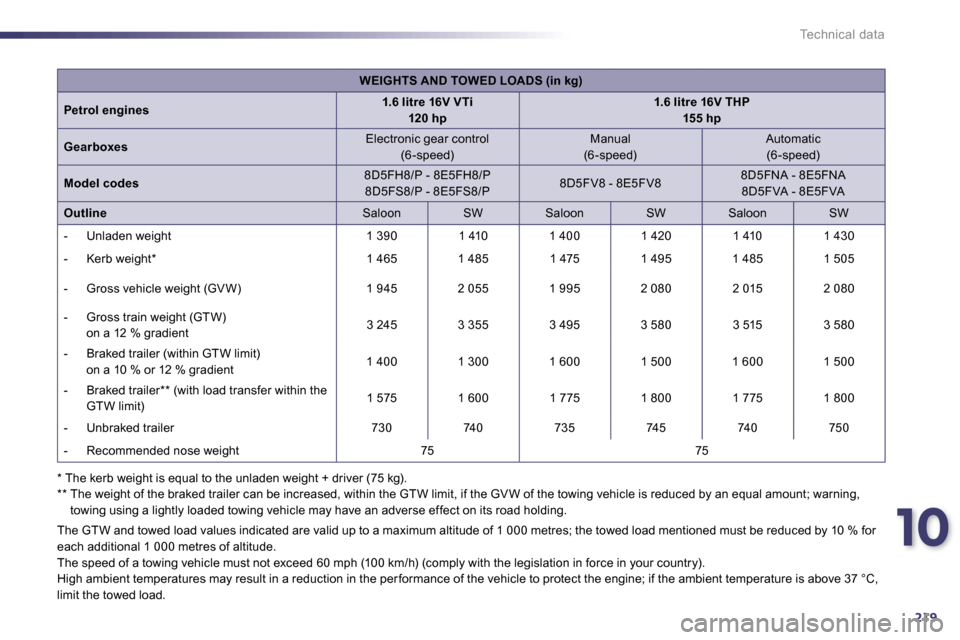
10
219
Technical data
* The kerb weight is equal to the unladen weight + driver (75 kg). ** The weight of the braked trailer can be increased, within the GTW limit, if the GV W of the towi ng vehicle is reduced by an equal amount; warning, towing using a lightly loaded towing vehicle may have an adverse effect on its road holding.
The GTW and towed load values indicated are valid u p to a maximum altitude of 1 000 metres; the towed load mentioned must be reduced by 10 % for each additional 1 000 metres of altitude. The speed of a towing vehicle must not exceed 60 m ph (100 km/h) (comply with the legislation in force in your country). High ambient temperatures may result in a reduction in the per formance of the vehicle to protect the engine; if the ambient temperature is above 37 °C,
limit the towed load.
WEIGHTS AND TOWED LOADS (in kg)
Petrol engines1.6 litre 16V VTi120 hp1.6 litre 16V THP155 hp
Gearboxes Electronic gear control (6 -speed) Manual (6 -speed) Automatic (6 -speed)
Model codes 8D5FH8/P - 8E5FH8/P8D5FS8/P - 8E5FS8/P 8D5FV8 - 8E5FV8 8D5FNA - 8E5FNA8D5FVA - 8E5FVA
Outline Saloon SW Saloon SW Saloon SW
- Unladen weight 1 390 1 410 1 400 1 420 1 410 1 430
- Kerb weight * 1 465 1 485 1 475 1 495 1 485 1 505
- Gross vehicle weight (GV W) 1 945 2 055 1 995 2 080 2 015 2 080
- Gross train weight (GTW) on a 12 % gradient 3 245 3 355 3 495 3 580 3 515 3 580
- Braked trailer (within GTW limit) on a 10 % or 12 % gradient 1 400 1 300 1 600 1 500 1 600 1 500
- Braked trailer ** (with load transfer within the GTW limit) 1 575 1 600 1 775 1 800 1 775 1 800
- Unbraked trailer 730 740 735 745 740 750
- Recommended nose weight 75 75